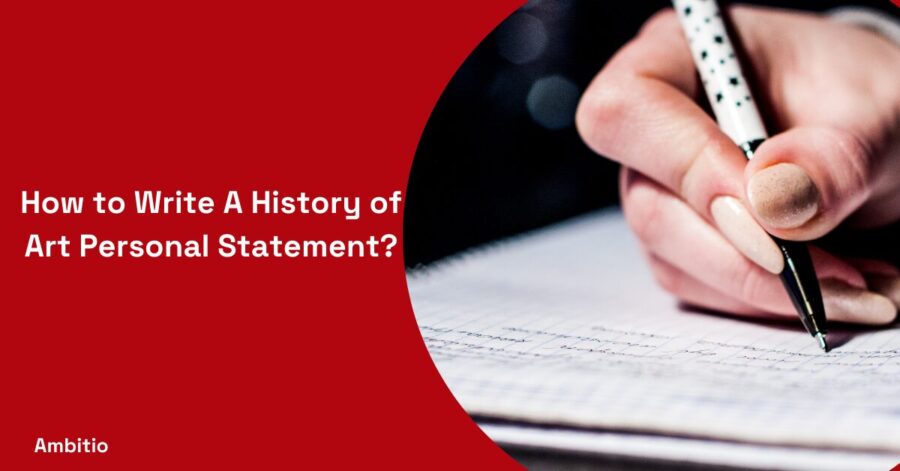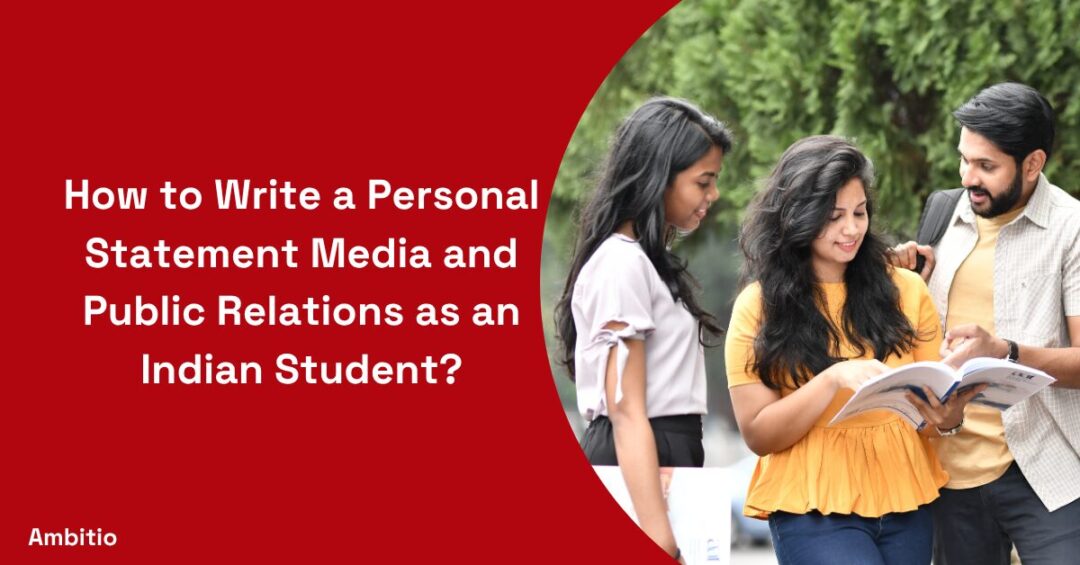5 February 2025
7 minutes read
How to Write A History of Art Personal Statement?

Key Takeaways
- A strong History of Art personal statement should tell your story clearly, avoiding clichés while showcasing critical thinking and academic curiosity in art.
- Beyond passion, demonstrate your ability to analyze artworks, conduct independent research, and apply interdisciplinary perspectives like philosophy and politics.
- Tailor your statement to each university, highlight practical experiences, and seek guidance from Ambitio, a trustworthy study abroad consultant for top admissions.
Did you know that John Berger ’s ‘Ways of Seeing’ revolutionized how we interpret works of art, shaping modern critical thinking in the field? Crafting a compelling History of Art Personal Statement is much like curating an exhibition—it requires precision, creativity, and a passion for art.
Whether you dream of studying at Oxford, Cambridge, or analyzing contemporary art at the Royal Academy, your statement should seamlessly express your keen interest in art history. This guide will help art students tailor a statement that showcases their love of the subject, their independent research, and their readiness to study art at a degree level.
6 Key Elements of a Strong Art History Personal Statement
The study of the history of art is more than analyzing artworks—it’s about understanding culture, expression, and the evolution of visual art across time. A well-crafted personal statement should demonstrate your ability to critique, interpret, and connect with the world of fine art. Whether you aspire to study at Oxford, or Cambridge, explore modern art at the Royal Academy, or curate collections at Sotheby’s, your statement should seamlessly convey your passion for art and commitment to this discipline.

Below are the key elements to tailor a compelling application.
1. A Strong Opening Statement
Your introduction should immediately engage the reader by explaining why you want to study History of Art, using a memorable quote, anecdote, or personal insight.
- Clearly state why you wish to study art history at a degree level.
- Mention a defining experience, such as a recent exhibition at Tate, the Guggenheim, or the Metropolitan Museum.
- Express your fascination with a specific medium, movement, or artistic period like Baroque or contemporary art.
2. Academic and Practical Engagement
Highlight school projects, essays, or extracurricular activities that shaped your understanding of art history, along with museum visits or art clubs that deepened your perspective.
- Discuss how your school’s curriculum, such as an extended essay or school magazine, allowed you to explore art history intellectually.
- Mention your participation in an art club, museum visits, or museums and galleries where you have deepened your understanding of sculpture and photography.
3. Independent Research and Critical Thinking
Demonstrate your ability to analyze and critique artworks by discussing self-directed research, applying art theories, or exploring various artistic interpretations.
- Showcase how you have undertaken independent research, perhaps analyzing Berger’s theories or applying Freudian perspectives to artworks.
- Demonstrate your ability to critique and analyze visual art extensively.
- Mention any university applications that have allowed you to explore different aspects of art history.
4. Personal Artistic Experience
If relevant, mention any photography, painting, or sculpture experience that helped you appreciate artistic techniques and creative expression beyond theoretical study.
- If applicable, discuss how you take pictures, experiment with colour, or study different mediums in your spare time.
- Highlight any practical fine art experience that has improved your ability to understand artistic techniques.
5. Career Aspirations and University Fit
Explain how studying History of Art aligns with your future goals in curation, academia, conservation, or museum work, and why a specific university is the best fit.
- Explain how studying at institutions like Brighton, Oxford, or Cambridge aligns with your particular interest in curating, museum work, or academia.
- If you have been fortunate enough to curate an exhibition, organize an art club, or work on an art-related project, mention it.
6. Conclusion
Reaffirm your passion for art history, emphasizing how this degree will expand your knowledge and help you contribute to the field in a meaningful way.
- Summarize your love of the subject and realise how studying history of art will help you expand your knowledge of art.
- Clearly state why you would like to see yourself contributing to the discipline at a degree level.
5 Tips for Writing Your History of Art Personal Statement
An impressive personal statement for History of Art involves a combination of passion, insight into academia, and understanding one’s own goals.

Below are some tips that may help:
1. Start with a Strong Opener
A compelling introduction sets the stage for a memorable personal statement. Avoid clichés and make your passion for art history clear from the start.
- Use a thought-provoking quote, personal anecdote, or unique insight to grab attention.
- Avoid generic statements like “I have always loved art” and instead, share a defining moment or experience.
2. Demonstrate Passion and Academic Interests
Your statement should reflect both your love for art history and your intellectual curiosity. Universities seek students who engage deeply with the subject.
- Discuss a specific artwork, movement, or artist that has influenced your thinking.
- Highlight academic coursework or research in history, literature, or philosophy that has enriched your understanding of art.
3. Highlight Work Experience and Critical Thinking
Practical experiences and analytical skills demonstrate your readiness for a degree in art history. Use real examples to showcase your engagement.
- Mention internships, Scholarships museum visits, or exhibitions that have contributed to your learning.
- Showcase your ability to critically analyze and interpret art by discussing research or unique perspectives.
4. Connect to Future Goals
Your personal statement should not just be about the past—link your experiences to your aspirations in art history.
- Explain how studying History of Art aligns with your future career goals in curation, academia, or research.
- Mention specific professors, modules, or research opportunities at the university that align with your interests.
5. Structure, Edit, and Perfect
A well-organized, error-free statement enhances readability and makes a strong impression on admissions officers.
- Maintain a logical flow from introduction to conclusion, ensuring each point builds on the last.
- Proofread carefully to remove filler words, check grammar, and refine clarity for a polished final statement.
5 Common Mistakes to Avoid While Writing History of Art Personal Statement
A captivating, insightful, and well-organized History of Art personal statement is crucial. The first few lines can make or break an application. Some of the common pitfalls to avoid are:
Avoid Generic and Overly Descriptive Openings
A strong opening should immediately engage the reader and set the right tone for your statement.
- Avoid clichés like “I have always loved art” and instead use a thought-provoking quote, anecdote, or insight.
- Don’t just list famous artists or museums—explain how they influenced your thinking and shaped your perspective.
Balance Description with Critical Analysis
Your statement should go beyond surface-level descriptions and demonstrate analytical depth.
- Instead of just describing artworks or movements, provide a critical perspective on their significance.
- Show how your understanding of art history is shaped by theories, historical events, and cultural contexts.
Incorporate Academic and Practical Experience
A strong statement should highlight both academic depth and hands-on exposure to art history.
- Mention relevant coursework, research, or subjects like history, literature, or philosophy that connect to your passion for art.
- Discuss museum visits, internships, exhibitions, or volunteer work, emphasizing how they shaped your analytical and practical skills.
Connect to Future Goals and University Fit
Admissions committees want to know how this degree aligns with your long-term aspirations.
- Clearly state how studying History of Art will help you pursue a career in curation, academia, research, or conservation.
- Show why you are applying to a specific university, mentioning professors, courses, or research opportunities that match your interests.
Ensure Clarity, Structure, and Proofreading
A well-structured and error-free statement is key to making a strong impression.
- Follow a logical format: Introduction → Academic Interests → Practical Experience → Future Goals → Conclusion to ensure clarity.
- Avoid overly complex language, proofread multiple times, and seek feedback from a mentor or tutor before submitting.
Examples of Successful Personal Statements
Finding inspiration for a compelling History of Art personal statement can be challenging, but learning from successful examples can provide a valuable shortcut.
Whether you’re a student of art navigating university applications or seeking guidance from a tutor on The Student Room, crafting your narrative creatively whilst showcasing academic depth is key to standing out. Here are two examples of a successful personal statements:
Example 1: Passion for Art in Historical Context
The moment I stood before Caravaggio’s The Calling of Saint Matthew, I was mesmerized by its interplay of light, tension, and narrative power. This woke my desire to study History of Art, to become not just a dreamy admirer but also a scholarly investigator of its genesis and socio-cultural importance.
My interest extends beyond the beauty of works of art to the socio-political contexts of various artistic movements, as explored during A-Level coursework on Impressionism’s attack on tradition. My volunteering at a gallery and my internship at a museum deepened my understanding of curation, conservation, and research.
I look forward to studying Baroque painting, visual culture, and museum studies at university, honing my analytical talents. With ambitions in art curation and research, I am focused on ensuring that art remains accessible and historically understood.
Example 2: Bridging Art with Other Disciplines
Art is the language that transcends time, culture, and ideology. My intrigue to study the history of art is connected to its interdisciplinary folds—intertwined with philosophy, politics, and psychology. It decodes the past to give shape to the future.
Studying literature and philosophy started my gradual awakening to the narrative power of art, from the parallels between Romanticism in poetry and painting to early modernist architecture’s impacts on society. This combined with an internship in a museum setting, and an online blog about specific contemporary updates, helped bolster the professional development I now carry with me toward curation, provenance research, and critical analysis.
My interests at the University of Windsor reside in visual culture, archival research, and digital curation. With aspirations in curatorship or arts journalism, my goal is to establish a continuing conversation and not a museum-piece with art.
Conclusion
When writing a History of Art personal statement that is briefly passion-oriented, think beyond raw passion and think about telling your own story clearly and purposefully. Your story is about your unique experiences, astute insights, and scholarly inquiries. Don’t use clichéd statements; use your own passion for this to land your future goals.
Ambitio is the trustworthy study abroad consultant to assist you with profile building and university selection to set you apart from the competition and land a coveted admission.
History is written by those who dare to stand out. With Ambitio Elite, craft a Personal Statement that makes admissions committees take notice. Ready to begin?
FAQs
What should I include in my personal statement?
Include your passion for art history, relevant experiences, and specific artworks that have influenced you. Highlight your academic background and understanding of art’s cultural significance.
How can I demonstrate my interest in art history?
Engage with art through museum visits and exhibitions, taking notes on your observations. Read extensively about art history to deepen your knowledge and provide material for your statement.
What writing style should I use?
Use a clear and confident writing style that is direct and articulate. Focus on honesty and coherence while ensuring grammatical accuracy.
How important is it to discuss specific artworks or artists?
Discussing specific artworks or artists is essential as it showcases your depth of knowledge and personal engagement. Explain their significance and relation to historical themes.
Should I mention any relevant work experience?
Yes, mentioning internships or projects related to art history strengthens your application. It demonstrates practical engagement and initiative in the field.
How do I connect my personal experiences to my academic interests?
Reflect on personal experiences that shaped your understanding of art history and connect them to your academic goals. This creates a cohesive narrative in your statement.
What common mistakes should I avoid?
Avoid generic statements and clichés that don’t reflect your unique perspective. Proofread carefully to eliminate errors that could detract from the professionalism of your statement.

You can study at top universities worldwide!
Get expert tips and tricks to get into top universities with a free expert session.
Book Your Free 30-Minute Session Now! Book a call now




























